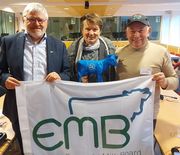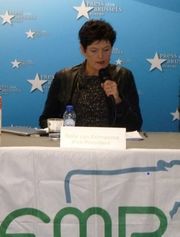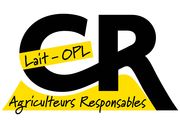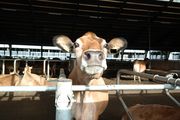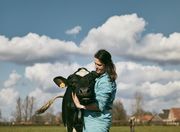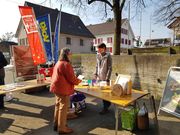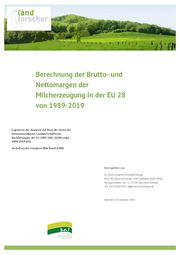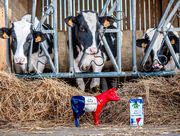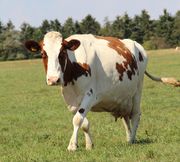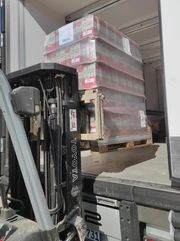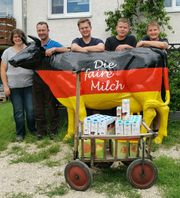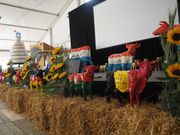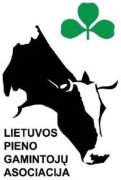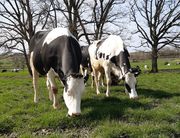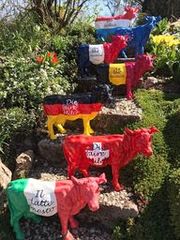Newsletter as PDF
Contact
EMB - European Milk Board asbl
Rue de la Loi 155
B-1040 Bruxelles
Tel.: +32 - 2808 - 1935
Fax: +32 - 2808 - 8265
Dear dairy farmers, dear interested parties,

Another eventful year is drawing to a close. Together with the European Milk Board, dairy farmers across Europe have engaged in countless activities, defending the interests of dairy producers, drawing attention to our political demands and presenting our proposals for sustainable farming conditions.
We at EMB wish to take this opportunity to thank all milk producers for their commitment and steadfast work in 2022! We would also like to thank consumers who have supported farmers, among others by purchasing Fair Milk products, and policy-makers who have advocated for a sustainable agricultural sector!
Alongside new contributions, the last edition of our newsletter in 2022 contains a selection of articles published over the past twelve months as we would like to take stock of key events at this time of year. In 2022, too, farmers have produced high-quality food day in day out, while at the same time defending their profession, engaging in political work and fighting for the survival of their farms and families' livelihoods. While the atrocious war in Ukraine has caused higher farm-gate prices in some countries, it has also driven up production costs, which is why the fight for stable and fair remuneration of dairy farmers continues.
We look forward to moving further down this important path in the coming year with you, toward a stable dairy sector in Europe. But now, it is time to enjoy a well-deserved break and get some good rest to gear up for another year of strong political work.
Merry Christmas and a happy and healthy year 2023!
Warm regards,
Your EMB colleagues
Kjartan Poulsen elected as new EMB Chair by European dairy producers
Brussels: The European Milk Board (EMB) will now be headed by its new Chair, Danish milk producer Kjartan Poulsen. At the EMB’s recent General Assembly, German BDM representative Elmar Hannen was also elected Deputy Chair. The previous Executive Committee members Boris Gondouin from APLI (France), Belgian MIG representative Guy Francq, his Irish colleague Pat McCormack from the ICMSA and Roberto Cavaliere from the APL (Italy) were re-elected to the Executive Committee.
European milk producers expressed their gratitude to the outgoing Chairperson, Sieta van Keimpema, who showed her unwavering commitment to European milk producers in her various functions at the EMB since its foundation in 2006. Through her tireless political work, she made extraordinary contributions to bolstering milk producers' representation at EU level. At this EMB General Assembly, her European colleagues, including many long-time colleagues such as the new EMB Chair, commended her outstanding services: "Sieta van Keimpema is an exceptional person for the EMB and we owe her a huge debt of gratitude. We wish her all the best for her future projects, into which she will undoubtedly invest just as much energy.”

Kjartan Poulsen had the opportunity to gain extensive political work experience in defending dairy producers in his former role as Deputy Chair. Working closely with his colleagues on the Executive Committee and the EMB member organisations, he will now focus more specifically on producers’ participation in the drawing up and implementation of the Green Deal, as well as on ensuring the costs linked to the various green strategies are covered. So far, policy-makers have been dictating what is to be done, without regard for the opinion and experience of European food producers. “This is a big mistake coming at a high cost for everyone. Without producers’ active involvement, there can be no successful climate policy”, Poulsen stated. As a focus for future work, the EMB General Assembly also determined that there should be an EU-wide regulation banning products from being sold below their production costs.
The Fair Milk Project epitomises the notion of fairness – another key EMB focus. Here, high-quality dairy products are matched with a fair price for the producers. In several European countries such as France, Switzerland, Belgium, Luxembourg and Germany, consumers can help to ensure that the costs of production, including a fair income, are secured for their farmers by buying fair products such as milk, chocolate milk, cheese, and butter. This project, which also allows producers to establish a direct relationship with consumers, must be broadened to ensure that more producers in other countries can enjoy prices that cover their full costs.
EMB press release of 20 December 2022
No more sacred cows!
Despite recent dairy price increases, a capricious system governed by speculators and unpredictable market swings remains unchanged. To guarantee food safety and security, as well as a fair income for farmers, the Fair Milk alternative should become the norm.
A lot is made of the pernicious effect of the Russian war against Ukraine on dairy prices in Europe. However, the current bout of inflation had already started rearing its head in the fourth quarter of 2021. Actual shortages resulting from the conflict can only partly account for the rise in costs rippling through global supply chains. Speculators are largely responsible for the situation on the market since their activities adversely affect producers as well as consumers. While higher food prices may be hard to stomach for consumers in the North, in the global South, their activities, siphoning off money to a handful of traders and companies, wreak havoc on populations who are already experiencing food insecurity.
Mirror clauses
At the macro-economic scale, it is governments’ laissez-faire trade policies, leaving the supply of vital commodities to markets, that have led us down the current path. In pursuit of shareholder dividends, European producers have been substituted by ever cheaper produce. While dairy farmers in the EU must meet stringent standards, global players rarely comply with the same food safety, social, and environmental standards. There is simply too little control over the quality of imports and production methods as regards animal welfare or the carbon footprint. When it comes to tackling ecological concerns, like excessive nitrogen or methane emissions, measures cannot be simply imposed on farmers unilaterally without consulting them, especially if these additional constraints are not reflected in farm-gate prices. As long as this will be the case, mirror clauses should be enforced so that European farmers are not undercut by products that do not meet the same stringent social, ecological and quality standards – something the EMB has been calling for persistently.
"We can’t afford to feed you anymore"
Unable to compete on price, Europe’s farmers are throwing in the towel at an unprecedented rate. Between 2003 and 2016, the number of farms in the EU-27 decreased from about 15 to 10 million (-32%). The smallest farms (<5 ha) are seeing the largest decrease (-38%). I remember a banner put up by dairy farmers from Northern Ireland at one of our demonstrations in Brussels, which read: "We can't afford to feed you anymore." The EU has become so dependent on global players that the slightest hiccup, or indeed an acutely inflamed appendix such as the Russian invasion of Ukraine, means a trip to the ER.
Dr. Karin Jürgens from the Rural Sociology and Agriculture Studies Office (BAL) conducted a study on margins, and several more on the cost situation of dairy farmers, which has systematically worsened over the last decades. Small dairy farms are the worst hit. Even those who are doing well are unable to obtain funding to make the necessary investments, for example, to help them keep up with increasingly stringent regulations. They are told that their farm lacks scale. Banks turn their noses up at them, saying: “Your farm is no longer future-proof.”
Across the global South, as land falls fallow, dairy cows are being slaughtered, and livelihoods destroyed. Threatened by famine, people would rather opt for a perilous journey north, where they are headed for an uncertain future, than face certain death at home. On the way, they risk falling prey to smugglers, having their mere existence considered a nuisance.
A higher standard
Slowly but surely, concern about dairy farmer attrition is growing among policy-makers. Today, food security is on the agenda like never before. So far, however, barely any concrete measures – if any at all - have been considered to remedy the situation, especially because farmers are not given a say in the policy discussions on this problem. We propose that Fair Milk become the standard. DG AGRI would do well to replicate the Fair Milk approach and apply it to the whole of the EU. Farmers elsewhere could also benefit from this, as the FaireFaso label in Burkina Faso and a similar initiative in Mali have shown.
Market Responsibility Programme
Since the 1950s, Canada has had a system in place that coordinates supply and demand so that stable prices can be set for consumers and farmers. In a tripartite approach, involving the government, the industry and farmers on an equal footing, they agree on a just price for milk. In the Netherlands, this is called the ‘three-legged stool’ approach, referring to the ones farmers used to sit on to milk their cows. Such a system is possible, provided markets are no longer regarded as a sacred cow.
The Market Responsibility Programme (MRP) proposed by the EMB to counter overproduction crises uses a cost calculation developed by Dr. Karin Jürgens as a starting point, ensuring that a certain price range is maintained. Whenever the actual price would leave this range, some aspects of the MRP, such as a voluntary reduction scheme, would be activated to ensure the price returns to the stable corridor.
Think global, trade local
Agriculture is too vital a sector to be left to speculators whose interests simply do not align with those of dairy farmers or consumers. In fact, agriculture should be taken out of the global free trade framework of the World Trade Organisation. At the end of the day, policy-makers have a simple choice to make and they should be clear and honest about it: we can have sustainable agricultural production, or we can have global markets where only the cheapest products are considered competitive; a race to the bottom where all but a handful of people lose. We cannot have both. Decades of mismanagement cannot be fixed overnight, but it is important to start the process as quickly as possible. Now would be a good time.
After many years of highly dedicated work for the EMB, Sieta van Keimpema will be leaving the EMB Executive Committee. She has been fighting for Europe's dairy farmers with much energy and effort. We deeply thank her for the exceptional work she has carried out for EMB farmers as member of the Executive Committee and as President.
Sieta van Keimpema, EMB Executive Committee 2006-2022 / EMB President 2020-2022
Milk production has lost over a quarter of its farms in a decade
The agricultural census conducted by the French Ministry of Agriculture every ten years gives us an overview of the French farming landscape and the trends inherent to ten-yearly developments across the country. Its latest publication on 10 December 2021 shows a 21% fall in the number of farms across all types of production.
Livestock farming is the sector most affected by this trend with a drastic decline: between 2010 and 2020, the number of farms has decreased by 31%, which is a loss of 64,000 farms. As regards dairy farming more specifically, the situation is alarming: over a quarter of farms have closed down in France over a ten-year period, a whopping 13,000 farms.
A decrease in the number of livestock farms, along with herd decapitalisation
According to the French livestock-farming institute (IDELE), France was home to roughly 3.6 million dairy cows and 736,000 heifers in 2020, i.e. 8.2% and 15.1% respectively fewer than in 2015. According to the IDELE, this soaring herd decrease is far from coming to an end. The institute has forecasted a sharp decline in the number of dairy cows: 441,000 by 2030, albeit with different regional dynamics. Some specific regions are strongly affected by this decrease, such as Nouvelle-Aquitaine, where the number of cattle has dropped by 45% between 2000 and 2019, compared with 19% at national level. The number of producers in this region has also plummeted, from 8,700 in 2001 to 2,500 in 2019.
At national level, the situation is alarming: milk producers aged over 50 accounted for 32% of dairy farmers in 2010, compared with 48% today, with 28% of them being over 55 years of age. According to the IDELE, the replacement rate for dairy farmers is a mere 45%, far from the 71% average across all farming sectors.
The national accounts confirm this trend
The recently published national accounts confirm that 2020 was marred by difficulties for dairy farmers. With a comprehensive 1.2% increase in expenses in 2019 linked to the increase in labour costs (+12.1%), repair and maintenance expenses (+10.7%) and the farmer’s social security contributions (+12%), the economic results of dairy farms once again show a decline (-1.9% for added value and -2.4% for gross operating profit per self-employed farmer). Mountain farms have generally fared better thanks to a better valorisation of their production.
The earnings before tax (EBT) per self-employed farmer fell by a net 6.8% in 2020 to an average of 26,052 euros per FTE. When the overall characteristics of dairy farms were analysed in 2020, it was observed that their self-financing capacity dropped by 3.7%, while their fixed assets increased by 2.6% and were funded by debt, also up by 3.1%.
For the year 2021, the upward trend in raw material prices has jeopardized the margins of dairy farmers because it has not been offset with an increase in farm-gate milk prices. In fact, the agricultural means of production purchasing price index (Ipampa) for cow’s milk shows an 11.9% increase in costs over one year, with a surge in the purchase price of animal feed and energy prices.
Véronique Le Floc’h, Coordination Rurale, France, January 2022
What are the start-up costs for young farmers in Denmark?
The job of a dairy farmer is multifaceted and demanding, and – as old hands in the business never tire of saying – can be very fulfilling. Yet anyone wanting to start producing milk faces huge challenges in every EU member state. Besides the intense price pressure and low or sometimes inexistent income for farmers and family members helping on the farm – a challenge every milk producer is confronted with – young farmers in particular also have to deal with the investment capital required.
How much capital do young farmers have to raise to start up in milk production? Fellow farmers from LDM in Denmark answered the question for their country, using the example of a farm with 210 cows and 150 hectares of land. The start-up capital required for this farm size in Denmark is roughly 3.87 million euros, broken down into:
-
2.3 million euros for immovable property and fixed assets
-
1.2 million euros for funding herds, equipment and movable property
-
Selling, general and administrative costs amounting to 70,000 euros, and
-
Initial costs for feed, operating costs etc. of 300,000 euros.
This amount of 3.87 million euros can be financed via:
-
Equity amounting to 200,000 euros
-
An equity loan of 500,000 euros (with 9% interest)
-
A mortgage loan over 30 years of 1.9 million euros
-
A 15-year bank loan of 1 million euros, and
-
A working capital loan of 300,000 euros.
For the farm, this financing incurs annual interest and principal payments of 270,000 euros.
A breakdown of these and further costs for the farm shows that the revenue per cow has to be 1,560 euros for all expenditure on interest, instalments and wages to be covered. If the farm manager’s remuneration is factored in, this amounts to a requisite revenue of 1,882 euros per cow.
According to LDM Denmark, for a young man or woman it is virtually impossible at the moment to afford a dairy farm in Denmark from his/her own funds. The Danish organisation says: “You have to have parents lending their child some of the money, or acquiring capital from people with money, or in some way share a farm for some time with the previous owner”.
“That’s why farmers in Denmark are getting older and older, because they can’t sell their farm at a price that covers their loans for it. In the last twelve months, 5% of dairy farms have closed down. Farmland is easy to sell to financial funds, but not the livestock.” That, says LDM, puts milk production in Denmark in a tricky situation.
Christen Sievertsen, LDM Denmark; Silvia Däberitz, European Milk Board, February 2022
Fair Milk in Belgium: quality in harmony with fair production and marketing
East Belgium: In recent years, the Fairebel label has become synonymous with fair agricultural products of the highest quality. What began as a reaction to the milk crisis in 2009, developed into a real success story. “At a time when farmers feared for their livelihoods due to rock-bottom milk prices, they received no solutions from policy-makers and decided that it was time to take things into their own hands”, remembers Faircoop President, Erwin Schöpges.
Fairebel, an initiative by and for farmers
A new brand was the solution: Fairebel was born! The aim of this new brand was to valorise regional agriculture and to make it less dependent on large corporations and their price dumping policies. Thus, Fairebel stands for “fair trade from and in Belgium”. With this new strategy of self-managed marketing, cost-covering prices were quickly achieved, with participating farmers guaranteed a secure income and traditional family farms being given a lifeline. “Looking back, this was clearly a great idea that strengthened Belgian agriculture”, says Erwin Schöpges. The Faircoop cooperative was founded by eight farmers – five of them from East Belgium. They engaged independently in negotiations with retailers to determine profit margins, balancing the two objectives of high-quality products for consumers on one hand, and more robust local farming structures on the other.
Well established in East Belgium
Currently, 500 farmers from all over Belgium are members of Faircoop, with a good 80 of them from East Belgium. “We lay special emphasis on the fact that we produce and thus distribute all over Belgium. This has allowed us, slowly but surely, to gain visibility among consumers”, says the Faircoop President. In this context, the figures speak for themselves: a total of 800,000 litres of milk were sold in the first marketing year 2010. The cooperative reached its first interim goal in 2020 by selling 11 million litres, the equivalent of one litre per Belgian resident. In the last few years, this figure has risen even further to 13 million, and the trend remains positive. This quick growth shows that the products have been well received by consumers for whom quality is a major concern. While the cooperative carries out joint publicity campaigns and is responsible for lobbying, all cooperative members are called on to contribute locally. The idea is to emphasize direct contacts with consumers so that they, too, identify with the brand and its products. As a result, you can regularly find participating farmers at weekly markets or tastings, where they not only proudly present Fairebel's products but also provide consumers with background information.
100% Belgian butter
In addition to drinking milk, Fairebel also makes chocolate milk, ice cream and grated cheese. For three years now, the cooperative has also been putting quality butter on the market. This butter is 100% Belgian and is made exclusively from Belgian milk. The participating dairy farmers commit to ensuring that their cows have access to pastures for at least six hours per day and for at least 120 days per year. This farming method, which guarantees maximum animal welfare, is the secret behind the unique and delicious taste. “In order to make Fairebel butter, we got together with one of the last family-run dairies in Belgium – the Olympia dairy from Herne in the Flemish-Brabant province. Olympia and the Van Impe family running it defend the same values we do and promote Belgian agriculture and fair remuneration for all stakeholders in the production chain”, says Erwin Schöpges. The milk used to make Fairebel butter comes exclusively from farmers in Wallonia and Flanders. “We collect the milk ourselves from the farmers and can attest to the quality of the milk and cream. This allows us to make pure butter. We use no additives as we trust the natural process where the excellent lactic acid bacteria at the Olympia dairy get to work to sour and flavour the cream. All these factors come together to give Fairebel butter its unique taste”, raves Erwin Schöpges.
20 litres of milk for 1 kilogramme of butter
A total of 20 litres of milk are necessary to produce a single kilogramme of butter. Modern scientific studies have debunked the widespread misconception that butter makes you fat and is not good for health. There has been a significant change in image when it comes to butter and it has finally regained its place in consumers' kitchens. According to Fairebel, this is clear from the current sales. The sales volume more than doubled from 250,000 packets in 2020 to over 500,000 packets last year. The initial months of this year have added to this boom as many new stores started stocking Fairebel butter. Fairebel is, therefore, quite confident that they will surpass the 1-million mark this year when it comes to packets of butter sold. “It is only thanks to our loyal customers, who do not go for cheap products or fall for offers from large companies, that we are able to continue living our dream of fair, cost-covering regional and national agriculture”, concludes Faircoop President Erwin Schöpges.
Gerd Hennen, Fairebel, June 2022
Rising costs put pressure on milk production
Skyrocketing energy prices are leading to far-reaching consequences. For many months now, milk products have become steadily more expensive around the world. This could be because many food corporations are capitalising on the situation and are using the excuse of rising energy prices to expand their margins. At the same time, milk production worldwide is either stagnating or decreasing. Rising costs and milk prices that do not cover these costs are leading to more farms going out of business and a reduction in production volumes. Since the phase-out of quotas in 2009, the number of dairy farms in Switzerland has reduced by one third. Today, only about 18,000 remain.
The dairy industry has always done all it could to put pressure on milk prices. In shops, however, prices for milk products keep increasing. The dairy price index by the Federal Office for Agriculture (FOAG) has been on the rise for months. The reference price for A-segment milk, however, has been languishing at 73 centimes for more than a year. In fact, producer prices are actually reducing month on month!
A short survey among dairy farms revealed the following: the rising prices for feed and energy alone have raised the cost of milk production by a whole 3 centimes per litre! It is high time that the dairy sector took some decisive action. They cannot afford to simply look on as milk production in Switzerland runs out of steam. The measly 2 to 3 centimes offered by individual retailers for compliance with higher standards are of no help at all. They are simply cancelled out by higher production costs. The additional burden of higher standards is, once again, being borne by farmers and their families. And policies laying down additional requirements are about to enter into force.
The dairy sector needs to balance its books! There needs to be a systemic change in how the milk price is determined on the dairy market. The milk price must be calculated on the basis of production costs and must be thus implemented on the market as well. Time is running out. The fact that our official producer representatives have not spoken out to date in favour of such a systemic change is already alarming enough. BIG-M and Uniterre call on the milk interbranch organisation to take a first step at their meeting on 2 March by raising the target price for A-segment milk by 9 centimes in the next quarter. Dairy farms need a timely, clear sign that would allow them to plan for the future.
Berthe Darras, Uniterre, and Werner Locher, BIG-M, February 2022
Make your own yoghurt, quark and Ziger cheese from Fair Milk
Through our cooperative "Faire Milch Säuliamt", we sell two types of pasteurised milk in the eleven branches of the VOLG chain of stores. Unfortunately, it is not possible for us to sell more dairy products via this channel.
This spring, the “Faire Milch Säuliamt” cooperative organised an information event outside six of the eleven outlets, where we demonstrated how to make your own yoghurt, Ziger cheese and quark from local Fair Milk from the Affoltern district. Customers showed a keen interest in this initiative. In addition to someone skilled in these techniques, members from the cooperative were also present to engage with customers. At the information stand, Perrine Brunold was happy to answer the many questions from interested visitors. She also offered samples of home-made yoghurt, quark and Ziger cheese – made from Fair Milk, of course. She showed how to easily make these products at home and also provided some tricks to overcome the most common difficulties.
Our expert Perrine Brunold was a cheesemaker for many years on a shieling in the Grisons canton. She is a two-time gold medal winner at the International Mountain Cheese Olympics in Galtür (Tyrol) for her alpine cheese. Her enthusiasm for milk products was infectious and her confections sold like hot cakes.
The strong interest from customers shows how aspects like origin and ingredients have become very important today when it comes to food. Many customers also highlighted how making their own products allows them to avoid large amounts of packaging waste and that this is an important factor for them.
About the “Faire Milch Säuliamt” project
The Faire Milch Säuliamt cooperative is made up of 43 members and has been selling 'Di fair Milch Säuliamt' pasteurised milk for almost five years through the Landi Albis (Albis Agricultural Cooperative) in the eleven VOLG stores as well as in three independent shops in the region. It offers whole milk, where fat content depends on what the cows have produced, as well as drinking milk with 2.5% fat. The price is calculated in such a way that farmers receive cost-covering prices for their milk. Sales have been steadily rising every year. This is also in part thanks to “Albis Beck”, Landi Albis's bakery, which supplies these stores with baked goods. When it comes to milk as an ingredient in their baked treats, Albis Beck only uses our regional milk. In the VOLG stores, our Fair Milk accounts for 85% of the market share for pasteurised milk.
Werner Locher, President of the Faire Milch Säuliamt cooperative, spring 2022
"A dramatic collapse"
A current study reveals the development in margins for EU milk producers and the fact that they have decreased significantly over the last 30 years, even sliding into negative figures to a large extent.
The study by the BAL (Büro für Agrarsoziologie und Landwirtschaft, Rural Sociology and Agriculture Studies Office) has calculated four types of margin for the EU for the period 1989-2019 respectively 2004-2019 with the gross and net margin and the net economic margin I and II, clearly indicating the development in dairy farming.
The gross margin for milk producers in 1989 amounted to 21.98 ct/kg milk, compared to only 15.15 ct/kg milk in 2019.
Gross margin = total milk revenue plus coupled milk subsidies minus input costs and general operating costs (excl. depreciation, wages, rent, interest [1] and taxes)
The net margin in 1989 amounted to 12.36 ct/kg milk, compared to only 4.17 ct/kg milk in 2019.
Net margin = same as gross margin but also after deducting depreciation, wages, rent, interest and taxes (but not including income for milk producers/family members helping on the farm)
The net economic margin I in 1989 amounted to 3.79 ct/kg milk. Negative figures started to be recorded already in 1995, with a value way below zero of -4.96 ct/kg milk in 2019.
Net economic margin I = same as net margin, but also after deducting a simple income rate for milk producers/assisting family members [2]
The net economic margin II is continuously negative in the period under review from 2004-2019 [3]. The deficit varies in this time between 5.3 and 13.5 ct/kg milk.
Net economic margin II = same as net margin, but also after deducting a qualified income rate for milk producers/assisting family members [4]
See here for the complete study.
Sieta van Keimpema, EMB President, finds the results alarming: "The figures show a dramatic collapse in margins for dairy farmers. This also reflects the situation on the farms. It is clear that the wrong course was set for the dairy sector in recent decades."
Profitability in milk production has become an alien concept, regardless of margin type. The same also applies to decent payment for hours worked. Nor is there any kind of respect or appreciation for the work of the dairy farmers. It is therefore no great surprise that farms have to close one after the other. France, for example, has lost a quarter of its dairy farms in ten years.
EMB Vice-President, Kjartan Poulsen, demands a new approach to agriculture. "We need a new system – one that is based on cost-covering prices. The distorted price/cost ratio faced by our own farmers, the unconditional, harmful focus on exports without sufficient scope for crisis prevention – this actual situation reveals the failure of the current agricultural system." A new agricultural framework must make it possible for prices to cover all previous costs of milk production and also the new costs generated by the higher sustainability requirements.
With a view to the margins, Kjartan Poulsen addresses clear words to the EU Commissioner for Agriculture: "Mr Wojciechowski, the data simply cannot be ignored any longer. You must work together with the farmers, the industry and the retail sector to look to the future and make every possible effort to make agriculture fair and profitable."
[1] Wages, rent and interest = external factors
[2] Simple wage rate = wage amount paid to employees / h x hours worked by family members (without employer's social security contribution)
[3] The necessary data are only completely available for the period from 2004.
[4] Qualified wage rate = twice the minimum wage / h x hours worked by family members (without employer contribution); the simple wage rate was used for Member States without statutory minimum wage (Austria, Denmark, Italy, Finland, Sweden and Cyprus). The qualified wage rate can only be ascertained for 2004 to 2019 due to missing data. The qualified EU wage rate is a weighted average wage (ascertained based on the weighted milk volume in the EU Member States).
EMB press release of 17 March 2022
France: dairy farmers unite in fairness and solidarity
It would be difficult to find a dairy farmer who was left unscathed by the milk crisis of 2009. Rozenn Angenard, dairy farmer in the Ille-et-Vilaine department in Brittany, as well as Isabelle Rouyer and Cédric Dumaine, from the Orne department in Normandy, remember this period where they poured away their milk to protest the rock-bottom milk prices.
They also admit that during this period “they gave a lot of milk away” and they remember “bartering with neighbours, consumers and other farmers”. The support from the French consumers and the solidarity among dairy farmers led to the creation of FaireFrance, a company set up by dairy farmers for dairy farmers. In order to become a member of FaireFrance, you have to contribute a minimum of 1,000 euros in capital, “and a maximum of 5,000 euros”, adds Isabelle Rouyer, one of the board members.
Like a shareholder in any other company, the producers take on the mission of promoting the FaireFrance brand among retailers and consumers. If this sounds scary, Rozenn, Cédric and Isabelle can put you at ease: “It's just two days hosting a stand in a store close to you if you have invested 1,000 euros, and five days if you have invested 5,000 euros.”
However, in exchange for their time, farmers receive a bonus that brings the price for their milk, which they continue to sell to their dairy, to 45 cents per litre. “A decent income”, “remuneration that allows you to plan a holiday with your kids”, “an additional income to build up a retirement fund” – that’s what Rozenn, Isabelle and Cédric say. They also add that the FaireFrance initiative is about more than “just” income. It is “one big family where we can discuss our problems and get help”, says Rozenn with a smile. Thanks to FaireFrance, this farmer from Brittany has “rediscovered the pleasures of her profession” and she enjoys talking to consumers who have many questions about dairy cows, their feed, and much more.
Ouest-France Communication for FaireFrance, published on 8 April 2022
Quality comes at a price
Some associations and companies keep trying to capitalise on market uncertainties to chip away at long-standing quality standards for agricultural products. The German small farmers’ association AbL calls for decent producer prices in the face of higher costs.
Ottmar Ilchmann, AbL spokesman for the dairy sector:
“It is important to maintain quality and to improve it, and to stop selling products for cheap rates, especially against the background of possible shortages. Until now, grass-fed milk was always readily available. As farmers, we were constantly told – you guys do it anyway. We like to produce in this way and we are also convinced about this approach. However, we are paid very little or nothing at all for upholding such high standards. This is also the case for the additional costs of GMO-free milk. Dairies use these factors to improve their image but they take no market action to ensure that their suppliers are adequately remunerated. There is enough GMO-free feed. Now is when dairies can and must make the most of market signals – to increase prices and pay farmers adequately for their quality milk. The large majority of consumers want GMO-free milk.”
To read the full article (in German):
Excerpt from a press release by AbL e.V. and VLOG e.V. on 19 May 2022
Fair Milk: a true sign of solidarity
With the Fair Milk project, producers do not just advocate for their profession, they also take action to help people in need. As this project belongs to dairy farmers and is managed by them alone, they can react quickly and make their small contribution through Fair Milk.
Please read on for reports from different Fair Milk countries about their concrete action during crises.
France
In early March 2022 and in collaboration with the radio station Echo FM, Fair Milk in France donated two pallets of milk to Ukraine. Jean-Luc Pruvot, President of FaireFrance, says: “I was at the Agricultural Fair when Didier Cornet, my contact at Echo FM, called me to ask if we could sell them one or two pallets of milk to send to Ukraine. After a short conversation, I quickly offered to make a donation to support the people of Ukraine in our own way because we all know that during a war, everything becomes critical: shelter, food, medical assistance... As farmers, the least we can do is help in addressing the issue of food.”
Belgium
Fair Milk in Belgium also provided Fair Milk products to people in need. Fairebel donated a pallet each of whole milk and chocolate milk on 7 March 2022 to Ukraine. When the Pepinster municipality in Liège province was flooded in mid-July last year, Fairebel sent a pallet of chocolate milk for the affected residents and many volunteers providing assistance.
Germany
Between July and October 2021, Fair Milk in Germany donated six pallets of chocolate milk and four pallets of milk and delivered them directly to the Ahr region that was severely affected by flooding. Oliver Koch, dairy farmer and Fair Milk participant from Harschbach in the Westerwald region, organised this donation and did some amazing work in this context.
Luxembourg
Together with the Kentucky restaurant in Lentzweiler, Fair Milk in Luxembourg donated long-life milk to people in Ukraine in early March.
Switzerland
Against the backdrop of the war in Ukraine, Faireswiss is donating a pallet of Fair Milk (720 litres) to an association receiving Ukrainian refugees in Geneva.

Vanessa Langer, European Milk Board, June 2022
Fair Milk in Germany: the Ströbele family from Ehingen
Our Fair Milk programme members introduce themselves: the Ströbele family from Ehingen in Baden-Württemberg has farmed for over 200 years. Together with his wife and his three sons Lukas, Felix and Fabian, Gernot Ströbele runs his farm with 65 dairy cows and young cattle.
From April to October, the cows graze in pastures, depending on the weather. For the rest of the year, they live in a spacious free-stall barn with outside access as well as all sorts of “cow comforts” in the form of brushes and showers, which are highly appreciated. The staple feed (grass, maize and broad beans) is entirely grown by the family itself.
The location of the farm, right next to the church in the centre of the village, is perfect for direct sales. The Ströbeles sell fair milk and fair chocolate milk, as well as home-made pasta and apple juice from their own orchards. A mobile cheesemaker also comes by regularly, with a range of delicious cheeses made from milk from the farm that are also sold on site.
The Ströbele family also offers a weekly delivery service and conveniently brings all its products to your doorstep within a range of 10 km.
Andrea Münnekehoff, Die faire Milch, Germany, June 2022
Open letter by European farmers to the European Union
We – the European farmers of ECVC and the European Milk Board who, as agricultural producers, are at the heart of food production – regard the current state of EU production systems with great concern. Unless action is taken immediately, it will no longer be possible to guarantee food security in the EU, i.e. the supply of key foodstuffs.
There is no doubt that the war in Ukraine and the coronavirus pandemic present major challenges to the EU food sector. However, there is another decisive factor that is severely endangering food security: the EU’s current agricultural system. While it is difficult to mitigate external wars and pandemics from within the EU, the European Union can and must adopt an agricultural model that can guarantee security of food supply in the medium and long term – despite internal and external crises. If such action is not taken, empty shelves and food shortages as well as the associated negative consequences will become part of our daily lives.
Status quo of the EU agricultural system is not an acceptable option for farmers and for the planet: predatory production structure
The rate at which the EU is losing producers is alarming. Due to chronic, rock-bottom producer prices that barely cover production costs, many farmers have already exited the food production sector. Farmers have no option but to give up on food production because despite their hard work, they are hardly able to make ends meet. In the dairy sector, for example, the average EU income per hour for dairy farmers is 4.19 euros; more specifically, 0 euros for Dutch producers, and 5.25 euros and 6.10 euros for their colleagues in Luxembourg and Germany respectively. Furthermore, constantly recurring crises and uncertainties as well as higher requirements on the part of the legislator, processors and retailers the costs of which are not covered push farmers out of business and prevent the next generation from entering the sector, which further exacerbates the situation. In key producing countries such as France, Germany and the Netherlands, the volume of milk produced is therefore declining.
The current explosion in production costs is accelerating this trend to such an extent that the production structure currently in place and expected for the future will be unable to ensure stable food production within the EU.
The main reason behind this problematic situation in the agricultural sector is the orientation of the EU’s agricultural policy in favour of cheap products and cheap exports, major trade liberalisation, global dependence and internal deregulation, coupled with the many associated crises in the sector, which have decimated producer structures. Multinational companies capitalise on this orientation, which also translates into massive dependence and weakens the autonomy of farms and of the EU – a potentially fatal blow for the economic and social situation of farmers. Over the last three decades, producer margins have shrunk to untenable levels. In milk production, for example, this reduction is clear from the Net Economic Margin I, which, in the EU, has slipped from 3.79 cents per kg of milk in 1989 to -4.96 cents per kg in 2019 – clearly in the red. Small and mid-size farms in particular – the backbone of our agricultural sector and rural life – as well as many larger farms cannot stay afloat faced with these conditions.
A robust, comprehensive structure would avoid production becoming concentrated in a small number of locations and thus the unhealthy industrialisation of agricultural production. For all these reasons, the status quo is not an acceptable option for farmers and citizens.
-
Producer prices must be coupled with production costs. No agricultural products should be sold below production cost! In Spain, a legislative act within the framework of the UTP directive currently leads to real improvements in the price situation. An effective obligation that prices must at least provide full cost coverage is necessary at EU level. We must do everything we can to prevent more producers from leaving the sector and to facilitate the entry of young farmers.
-
We need to stop or roll back deregulation! The goal must be a balanced market. Suitable crisis instruments must be integrated into the EU agricultural system. This includes a functioning early-warning mechanism, built around correct indicators that reflect real production costs, including appropriate producer income.
-
For the dairy sector, for example, we need different objectives and a different functioning of the CDG Milk and the MMO (Milk Market Observatory), which really need to actively work on a balanced and fair redistribution of added value and which should not just continue to passively observe the distortions from afar.
Green Deal & Farm to Fork – sustainability strategies without sufficient involvement of producers and without necessary tools for implementation
Even though it is clear that an environment and climate policy without the necessary tools and without the involvement of agricultural producers cannot work. These aspects have been massively neglected in the Green Deal and the "Farm to Fork" strategy. The already rampant predatory production structure should have been reformed to create the necessary preconditions for a successful sustainability strategy. This opportunity was squandered.
Furthermore, producers should have been empowered with the necessary tools to fulfil the numerous sustainability targets. Instead, these objectives have been simply placed before them and they have been left to bear the entire burden of these strategies, which is impossible given the already distressing income levels in the agricultural sector.
-
Producers must be placed at the heart of agricultural strategies and must be appropriately involved in shaping them. Policy-makers must work in cooperation with farmers. Comprehensive tools to achieve sustainability targets must be provided, in particular by offering the means to expand to short circuits, fair trade and collective catering. The Green Deal must be used to reform the current system towards a socially sustainable model. Without the people who produce food on farms, a Green Deal or "Farm to Fork" strategy serves no purpose.
Imports that do not align with EU standards
As agricultural imports in many areas do not comply with EU standards, European consumers are faced with greater health risks and EU farmers with damaging distortions to competition. Within the context of stricter EU sustainability standards in the future, which will not be upheld outside the EU, greater uncertainty is to be expected.
-
To counteract this development, we need mirror clauses to ensure that imported food and feedstuffs comply with EU requirements, and enforcement must be guaranteed through comprehensive controls and sanctions.
Trade liberalisation and cheap exports put local production under pressure – in the EU and in the rest of the world
The strong trade liberalisation approach has significantly increased the EU’s dependence on externally produced goods, and external, global dumping prices – instead of adequate EU prices in line with local production standards and costs – dominate the scene. This leads to producers worldwide struggling under the pressure of cheap products, something that is evident from the extremely low producer prices in the EU and translates into the dumping of cheap milk powder on local markets for our colleagues in West Africa.
-
Reduce the dependence on imports and damaging cheap exports by excluding agricultural products from WTO and free-trade agreements. A responsible EU trade policy would completely disallow the dumping of cheap products on sensitive markets.
The farmers of ECVC and the EMB are highly concerned and alarmed. Our agricultural system must be reformed NOW. There is no time to loose because the EU is treading on thin ice that has already given way in many places. Now is the time to do everything in our power to bring lasting stability to our production structures in terms of sustainability and resilience, in the perspective of food sovereignty in the EU and worldwide. Without the people that ensure food production, there will be no food and this will be devastating for food security in the EU.
European Milk Board and European Coordination Via Campesina (ECVC), July 2022
Fair, Fairer, Faironika
During the milk strike or while spraying the European Parliament in Brussels with milk, on World Milk Day alongside Manneken Pis or at the innumerable Fair Milk tastings in or outside supermarkets, at Europe-wide protests, agricultural fairs and press conferences or in many, many fields at the heart of Europe: Faironika, the EMB’s symbolic cow in different national colours has stood with farmers for 15 years and embodies their call for fair milk prices.
For the European Milk Board (EMB), this is a special milestone that deserves to be celebrated. EMB President Sieta van Keimpema believes that the mascot – also known as Justine or Onestina in different languages – is a friendly yet fiery fellow combatant with high impact. “15 years of Faironika – 15 years as THE symbol for fair milk. Farmers, consumers and policy-makers across Europe and, to some extent, in Africa as well recognise her and know what she stands for. This has been made possible thanks to the great work by EMB members and the successful Fair Milk projects.” Boris Gondouin, EMB Executive Committee member from France says that in this way, Faironika is also a symbol of mutual trust and solidarity: “Through Faironika, farmers show that they are united with their fellow milk producers in Europe and Africa and highlight the importance of a fair agricultural policy for farmers and citizens alike.”
Guy Diderrich from EMB member organisation LDB, who are the organisers of this year’s anniversary celebration in Luxembourg and have prepared a big cake as a birthday surprise for Faironika, looks back proudly over the past years, at the fighting spirit of his colleagues and the tireless commitment of this symbolic cow: “For 15 years now, Faironika has always been there at the effective, creative actions by farmers, and she will continue to be by our side during our intensive discussions, efforts and campaigns for a fair milk price. We farmers from across Europe, together with our colleagues from Africa, know that we must make our voices heard so that fair income for farmers and a stable food production system become a reality.”
Come rain or shine, in the north, south, east or west of Europe or even in Africa: Faironika, Justine and Onestina in their respective country colours or in the EU blue will stand at the forefront of all future actions and will continue to support dairy farmers in their struggle for fair milk prices that will ensure a decent income in the agricultural sector.
Farmers wish Faironika, Justine and Onestina “Happy Birthday”
Carlos Neves, APROLEP, Portugal:
"The cow Faironika is for us the symbol of the unity of European dairy farmers with EMB in our peaceful, but firm fight for a fair milk price and a better life for all farmers from here in western Europe via Luxembourg to eastern countries, without forgetting Ukraine. Together, we are strong!"
Markus Hafner, South Tyrol/Italy:
"Best wishes from South Tyrol to Faironika and all our friends across Europe. Cheers to you!"
Paul Smyth, ICMSA, Ireland:
"We dairy farmers love Faironika because it represents a fair milk price across Europe for all dairy farmers. In Ireland, we believe in a fair milk price, which contributes to the sustainability of our family farms."
Boris Gondouin and Jean-Luc Pruvot, APLI and FaireFrance, France:
"It is plain to see that we love Justine – after all, she is wherever we are. She symbolises our political fight for cost-covering prices in Europe. But she is also the mascot of our FaireFrance brand and that is really important.
Justine has been our mascot for 15 years now – we were, in fact, the pioneers of Justine. She takes us on amazing adventures and as Muhammad Ali said: “It isn’t the mountains ahead to climb that wear you out; it’s the pebble in your shoe.” It is thanks to Justine and the energy of everyone we met along the way that we were able to launch our brand in France. It is a true pleasure to celebrate this milestone today. Happy Birthday!"
Elmar Hannen, BDM, Germany:
"Hello dear friends – it is time to celebrate Faironika’s birthday. She is synonymous with all these years of political struggle as well as our efforts with other stakeholders along the value chain for fair treatment. And we will continue this fight till we reach our goal."
Anne Chenevard, Faireswiss, Switzerland:
"On her many travels with Faireswiss, Justine ended up with three chipped legs and a damaged horn. But Justine is a bit like us, she never gives up. She might be brought down to one knee, but never to both. She gets back up and doesn’t lose hope. Justine will never give up and she believes in the future of fair milk."
Henning Haschenburger, Karolina Klaus-Althaus, Peter Habbena and Karsten Hansen, BDM, Germany
"Faironika, our symbolic cow, is at all our demonstrations, where she is noticed and showcased by the press. She is a sign of farmers fighting to defend their rights. For me, Faironika stands for our long-standing struggle, for change and for cost-covering prices in the agricultural sector. I am proud to have a Faironika on our farm.
Faironika – a love affair that dates back to 2015. The images from demonstrations in Brussels were simply fascinating and seeing this community with all these cows in their different national and European colours really sealed the deal for me.
Faironika – she is not just a German project, but a European one. Together, we fight for a fair milk price and the value of milk in Europe."
Kjartan Poulsen, LDM, Denmark:
"Dear Faironika, it is good to have you with us. It is a symbol of our struggle for fair income for farmers. Thank you!"
EMB and LDB press release of 4 July 2022
Lithuanian CAP Strategic Plan
In Lithuania, farmers are disappointed at the way in which the Lithuanian CAP Strategic Plan was prepared. The Lithuanian Ministry of Agriculture worked on the Strategic Plan behind closed doors, excluding farmers from the process and not taking their input into account. As a result, dairy farmers are not happy with the outcome of the Lithuanian Strategic Plan.
Against this backdrop, farmers’ organisations, including the Lithuanian Milk Producers' Association (LPGA), have voiced their disapproval with the ministry’s work. In addition, Lithuania failed to seize the opportunity to use the Recovery and Resilience Facility (RRF) funds available from the European Agricultural Fund for Rural Development aimed at modernising agriculture and developing new technologies.
Instead, the government earmarked a mere sliver of the available funds for the recovery of wetlands, without setting aside any funds from the RRF for agriculture. In view of these developments, farmers’ organisations are currently calling for the minister of agriculture to be replaced.
Given the new realities created by the war in Ukraine, farmers see the CAP Strategic Plan as lacking because it fails to address the issue of sufficient and adequate food production. The farmers’ organisations believe that the plan threatens to further reduce production. The European Commission’s many comments on the Strategic Plan should be seen as an opportunity to improve it and to strengthen the involvement of farmers in this process.
Eimantas Bičius, Executive director, Lietuvos pieno gamintoju asociacijos (LPGA), August 2022
The interplay between climate change and pasture grazing
We farmers are committed to climate protection because we are directly affected by the fallout of climate change. There are many different ways to mitigate climate change. When looking at greenhouse gas reduction in dairy farming, case-by-case evaluation is essential as carbon emissions strongly depend on the location, structure and type of farm and use. Dairy farming is not per se a climate killer as is often claimed.
It is clear to see that the discussion remains superficial and that the complexities of milk production are not analysed in their entirety. This results in the positive climate effects of dairy farming not receiving due consideration. When it comes to maintaining permanent pastures, for example, dairy farming is essential. A cow can convert grass, which is not fit for human consumption, into nutritious milk. Furthermore, grassland sequesters carbon and thus has a positive effect on the climate. Hennig Haschenburger, for instance, has chosen grass-based, ruminant-friendly feed and pasture grazing on his farm at the North Sea coast, with natural, regional circuits also playing an important role. You can learn about how he puts this into practice on his farm in a video (available in German). We would also like to point you to our position paper on climate protection (also available in German).
Federal Farm Minister Özdemir defers eco-schemes
The first instance of obligatory set-asides in the coming year is to be deferred. Cultivation will still be permitted, but it shall be limited to cereals (except maize), sunflowers and pulses (except soy). This only applies to areas that were not already classified as fallow arable land in 2021 and 2022. Scientific calculations project about 100,000 to 180,000 hectares of arable land thus continuing to remain available for cereal production. A one-off derogation from the requirement for crop rotation is also foreseen for 2023. This means that farmers in Germany will be able to grow wheat followed by wheat in 2023 as well. In previous years, this was the case on about 380,000 hectares. However, it is worth contemplating whether these decisions will help alleviate global hunger (that has existed for decades) as well as whether the current developments towards increased production will have a positive effect on prices for agricultural raw materials.
BDM confers journalism award
At the farm of our BDM members, the Fockenbrocks family, in Telgte in the Münsterland region, we honoured Kirsten Gierse-Westermeier and Stefanie Dullweber with our journalism award in the “trade press” and “print media” categories. The traditional ceremony as part of the BDM symposium was unfortunately not possible as it had to be cancelled on account of the COVID-19 pandemic. Due to organisational reasons, we already awarded Ulrike Werner in the “radio” category on 1 June as part of our demonstration in Berlin on the occasion of World Milk Day.
Bundesverband Deutscher Milchviehhalter (BDM), September 2022
Fair Milk in 2022: buying local is still worth every pennyFair Milk in 2022: buying local is still worth every penny
We asked our Fair Milk producers to look back on 2022 and to give us their forecast for the coming year. Assessments differ from country to country, but all agree that Fair Milk is still necessary.
In Germany, Michael Braun, Managing Director of 'Die Faire Milch', sees a continued need for local and regional food supplies. “Both the COVID-19 pandemic and the war in Ukraine have shown how important it is to keep food production close to consumers. By purchasing Fair Milk products, consumers contribute to preserving family farms in their region and to securing supply. At the same time, they also foster sustainability and animal welfare. In this respect, Die Faire Milch’s new fresh organic pasture milk is a true success.”
Speaking of the COVID-19 pandemic, in 2022, Fair Milk partners were happy to be able to go back to holding events in person again. In Switzerland, in-store tastings organised by Faireswiss producers resumed, and so did press conferences to present the various Faireswiss cooperative producers and agricultural organisations in different cantons: Jura, Ticino and Valais. This year, Faireswiss also celebrated its third anniversary with a tasting in a grocery store – an event which will be featured in RTS’ (Radio Télévision Suisse) programme ‘Temps présent’, to be broadcast at the end of the year. Faireswiss has planned over 30 events in stores to promote their products in the coming end-of-year season.
Rising prices
As a result of the war in Ukraine and the pandemic, prices of dairy products in supermarkets have spiked, as have, to a lesser extent, prices paid to farmers. Before the crisis, the farm-gate price for a litre of milk was well below its cost of production. The Fair Milk label was able to bridge this gap. With higher milk prices currently being paid to farmers in some countries like Luxembourg, the Netherlands and Denmark, this gap has narrowed, or even closed. However, this is not the case in Belgium, France and Germany since production costs have increased commensurately.
Carine Dumont of Faircoop, the organisation that markets Fairebel dairy products, fruit and meat, notes that energy costs in particular have gone up sharply in Belgium. At the same time, higher overall dairy prices have led to a drop in the consumption of these products. After the abolition of the milk quotas in 2015, producers were encouraged to massively increase their volumes, which were then to be exported. Carine Dumont, a dairy farmer herself, says: “We are producing more milk than ever and we’re still hardly able to make ends meet.”
Boris Gondouin of Fairefrance and EMB Executive Committee member, says: “With prices around 45 cents per litre, French dairy farmers are among the lowest paid in Europe. Production costs are at around 55 to 60 cents, so the gap has not narrowed for us. Supermarkets are unwilling to increase retail prices for consumers. In France, a law is to be passed to ensure the selling price matches the production costs, but nothing has come out of this so far.”
As for the countries where the farm-gate prices match production costs, he says: “Even non Fair Milk producers are receiving a price covering the production costs, but this will not last. If Fair Milk is removed from the market, quickly reintroducing it to consumers will be difficult. So, yes, Fair Milk is still needed today, and will be even more so tomorrow. Farmers need to be paid an amount well above that of their production costs. Starting farmers need to be able to pay off the expensive equipment and infrastructure they’ve invested in.”
Uncertain 2023
For the coming year, uncertainties abound. How will energy, raw materials and packaging prices evolve? Michael Braun says: “We must never get tired of sending the clear message that we are a brand created by dairy farmers and that this is therefore a real alternative on supermarket shelves, not only for consumers but also for retailers. For them, our brand is one of the few alternatives available in an increasingly concentrated dairy market. Without a doubt, a fair price for milk is in everybody’s interest."
Tom Kenis, European Milk Board, December 2022
Legal notice
European Milk Board asbl
Rue de la Loi 155
B-1040 Bruxelles
Tel: +32 2808 1935
Fax: +32 2808 8265
E-Mail: office@europeanmilkboard.org
Website: http://www.europeanmilkboard.org

